- About Ramapo
- Academics
- Admissions & Aid
- Student Life
- Athletics
- Alumni
- Arts & Community
- Quick Links
- Apply
- Visit
- Give
Newsletter

Fall / Winter 2012
In This Issue
- Film Exploring the Limits of International Justice on Reconciliation in Post Civil War Sierra Leone Screened
- Legacy of Champion of Children and Holocaust Hero Janusz Korczak Explored
- Controversial New Work on Confiscation of Jewish Property in Holocaust Discussed
- Film Illuminates Life and Work of the German-Jewish Architect Erich Mendelsohn
- Noted Researcher Examined Post-Genocide Justice in Guatemala
- Fate of Jewish Lawyers in Nazi Germany at Kristallnacht (Crystal Night) Commemortation Discussed
- Teaching about the Experiences of Children Focus of Gumpert Teachers’ Workshop
Film Exploring the Limits of International Justice on Reconciliation in Post Civil War Sierra Leone Screened
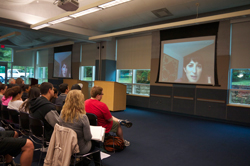
Students from several classes participated in a Skype conference with the director of “War Don Don,” Rachel Richman Cohen (October 4, 2012)
(MAHWAH, NJ)- Director Rebecca Cohen led a Skype discussion of the film War Don Don, at Ramapo College of New Jersey on October 4. The screening was cosponsored by the Center for Holocaust and Genocide Studies and the Communications major’s Cinematheque series. A mostly student audience of 200 participated in the event.
War Don Don, Richman Cohen’s directorial debut, follows the war crimes trial of Revolutionary United Front (RUF) rebel leader Issa Sesay. It explores the complex relationship between individual accountability, collective reconciliation and the limits of international justice. While the people of Sierra Leone were relieved in 2002 when the 10-year violent war was over (exclaimed as “war don don” in the Krio language), painful memories of murder, systematic rape and dismemberment could not be set aside.
Rebecca Richman Cohen is an Emmy Award nominated filmmaker and a lecturer on law at Harvard Law School. She interned as an investigator at the Bronx Defenders and continued to do investigative work at the Special Court for Sierra Leone.
Between trips to Sierra Leone, she has been adjunct faculty at the Rhode Island School of Design (RISD) and American University’s Human Rights Institute. Rebecca graduated from Brown University with a B.A. in Portuguese and Brazilian Studies and with a Juris Doctor from Harvard Law School, where she now teaches.
Legacy of Champion of Children and Holocaust Hero Janusz Korczak Explored
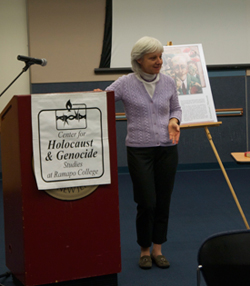
Mariola spoke to an audience of students and community members about the life and legacy of the educational theorist and Holocaust hero, Dr. Janusz Korczak (October 11, 2012)
(MAHWAH, NJ) – Mariola Strahlberg, the Chairperson of the Janusz Korczak Association of the USA, and founder and executive director of the Shining Mountain Center for Peaceful Childhood, Inc., spoke at Ramapo College of New Jersey about “What We Do Really Matters: The Life and Legacy of the Champion of Children and Holocaust Hero Dr. Janusz Korczak“ on October 11.
The pediatrician and pedagogue Janusz Korczak (born in 1878 as Henryk Goldszmit) is best known outside his native Poland mainly through Andrzej Wajda’s acclaimed film Korczak. It poignantly depicts his steadfast refusal to abandon the nearly 200 children of the orphanage he ran in the Warsaw ghetto, even in the face of multiple offers of rescue from Polish friends.
An engaging writer and public speaker, Korczak’s work was known and highly regarded throughout the world during his lifetime. His work at the orphanage has exerted considerable influence on schools and extracurricular educational institutions throughout the world, including his own native Poland as well as Germany, Israel, France and Russia.
Mariola Strahlberg, M.S, L.Ac. works with children who are experiencing challenges in their lives and helps them find a way to reach their highest potential. Inspired by Janusz Korczak’s idea of allowing children to be responsible for their thoughts, words and deeds, she made it abundantly clear his ideas are still pertinent for us today.
Controversial New Work on Confiscation of Jewish Property in Holocaust Discussed
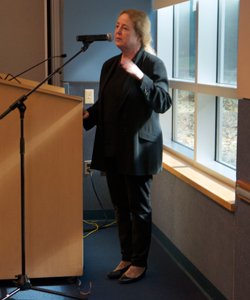
Dr. Irena Grudzinska Gross answered questions after a presentation about the book she co-wrote with Jan T. Gross, Golden Harvest, on the plundering of Jewish property during the Holocaust (October 16, 2012)
(MAHWAH, NJ)- Dr. Irena Grudzinska Gross, co-author with Jan T. Gross of Golden Harvest: Events at the Periphery of the Holocaust (Oxford University Press, 2012), spoke on October 16 about “Plunder from Jews during the Holocaust.“ Ramapo College’s Platinum Series supported the event, and it was co-sponsored by the Law and Society program and the Center for Holocaust and Genocide Studies.
The grainy black-and-white photograph on the cover of Golden Harvest ?¦ of a group of peasants digging atop a mountain of ashes at Treblinka, where some 800,000 Jews were gassed and cremated, symbolizes the vast, continent-wide plunder of Jewish wealth that went hand-in-hand with the Holocaust.
The seizure of Jewish assets during World War II generated widespread attention when Swiss banks were challenged to produce lists of dormant accounts, and when national museums were forced to return stolen paintings.However, among the countless people who in one way or another during the Holocaust obtained or helped themselves to Jewish property were mainly ordinary people. For a variety of reasons, as Grosz explained, this was especially true in Poland, which had pre-war Europe’s largest Jewish population. Nevertheless, Golden Harvest, often in lyrical and heartbreaking terms, exposes the economic plunder of Jewish property across the entire continent of Europe.
Especially in Poland, as Gross made clear, uncovering the truth has not been an easy process. It had to wait until now for honest public dialogue to begin because, like elsewhere in Europe too, a narrative about the Second World War existed in which Poles saw themselves only as victims of Nazi oppression. Relatively recent revelations about Poles having carried out pogroms against Jews and having betrayed Jews in hiding have opened the possibility of a more nuanced assessment of the role of Poles in the Holocaust.
Dr. Gross teaches East European literature at Princeton University. She emigrated from her native Poland after the student unrest of 1968. She studied in Italy and in the United States. A graduate of Columbia University (1982), she has taught at Emory University, New York University and Boston University.
In addition to Golden Harvest, her books include CzesÅ,aw MiÅ,osz and Joseph Brodsky: Fellowship of Poets (Yale University Press, 2009) and The Scar of Revolution: Tocqueville, Custine and the Romantic Imagination (University of California Press, 1995). She edited books on literature and the transformation process in Central and Eastern Europe and is the author of numerous book chapters and articles on these subjects published in the international press and periodicals.
Film Illuminates Life and Work of the German-Jewish Architect Erich Mendelsohn

Duki Dror in a Q&A with students after the screening of his film, Mendelsohn’s Incessant Visions,that delves into the life and work of the German-Jewish architect Erich Mendelsohn (October 18, 2012)
(MAHWAH, NJ)- Director Duki Dror screened and led a discussion of his film Mendelsohn’s Incessant Visions, on October 18. The Center for Holocaust and Genocide Studies and the Art History program of Ramapo College cosponsored the vent.
Incessant Visions, a seductive and complicated new documentary from Israeli director Duki Dror, tells the story of the German-Jewish architect Erich Mendelsohn’s many triumphs, from his rise as an architectural superstar in Berlin and his triumphant designs in the Middle East and America, to bitter disappointments in all the same places.
Mendelsohn was one of the great German architects of the Weimar era who designed a series of iconic structures, from the Einstein Tower (1919-1921) that housed the astrophysical observatory in the Albert Einstein Science Park in Potsdam to a number of modernist department stores for the Schocken concern in the late 1920s. Forced to leave Berlin after Hitler came to power in 1933, Mendelsohn continued his architectural career in England, Palestine and the United States. The film delves into the development of his life and work by blending letters and drawings and interviews with period and contemporary footage.
A native of Tel Aviv, Israel, Duki Dror studied theater and classical studies in UCLA and graduated from the Colombia Collage film school in Chicago. His graduate film, Sentenced to Learn (1993), which tells the story of inmates sentenced to life in Illinois prisons, was selected to screen in a historical retrospective of American Documentary at the Pompidou Center in Paris.
Among his other notable films are Radio Daze (1996), depicting the life of a radio-quiz-show-star, and Taqasim (1999),showcasing the work of musicians from Iraq and Egypt, who immigrated to Israel during the 50’s and led their lives in virtual obscurity.
Noted Researcher Examined Post-Genocide Justice in Guatemala
(MAHWAH, NJ) – Dr. Victoria Sanford, Director of the Center for Human Rights & Peace Studies and Professor of Anthropology at Lehman College & the Graduate Center of the
City University of New York, spoke at Ramapo College of New Jersey on October 24 about “The Guatemalan Genocide–Command Responsibility and Possibilities for Justice.” The History Club, Human Rights Society and Center for Holocaust and Genocide Studies co-sponsored the talk.
Between the late 1970s and the late 1980s, Guatemala was torn by mass terror and extreme violence in a genocidal campaign against the Maya, which became known as “La Violencia.” The Guatemalan Truth Commission documented 626 village massacres and 200,000 dead or disappeared in the Guatemalan genocide of the 1980s.
Drawing on two decades of research in Guatemala and a thorough review of declassified US government documents, Sanford explored the three phases of the Guatemalan genocide and pointed to command responsibility on the part of current and former members of the Guatemalan army. She also discussed ongoing genocide cases in the national and international courts, especially the various proceedings against the former dictator, Efrain Rios Montt.
Sanford received her Ph.D. in Anthropology from Stanford University in 2000, where she also received training in International Human Rights Law and Immigration Law at Stanford Law School. Additionally, she received a certificate in Human Rights Law from the Inter-American Institute of Human Rights in Costa Rica.
Sanford joined the Lehman College and City University of New York anthropology faculty in Fall 2004. Previously, she was Senior Research Fellow at the Institute on Violence and Survival at the Virginia Foundation for the Humanities. She has also taught in the Department of Rural and Regional Development at the Pontificia Universidad Javeriana in Bogotá, Colombia, Stanford University, and the University of Notre Dame where she was appointed Faculty Fellow at the Kroc Peace Studies Institute and the Kellogg Institute for International Studies.
She has worked with Central American refugees since 1986 when she founded and directed a non-profit refugee legal services project representing Central American asylum-seekers. As a human rights activist and scholar, she has conducted extensive field research with Maya communities in Guatemala, Afro-Colombian and indigenous peace communities in Colombia, and Colombian refugee communities in Ecuador. Her research focused on collective memory, community reconstruction, human rights, and international humanitarian law during internal armed conflicts and in post-conflict countries in Latin America and Africa. Sanford is an expert on post-conflict violence, drug-trafficking, and crime with a specific focus on forensic investigation and judicial reform.
She is the author of Buried Secrets: Truth and Human Rights in Guatemala (Palgrave Macmillan 2003), Violencia y Genocidio en Guatemala (FyG Editores 2003) and co-author of the Guatemalan Forensic Anthropology Foundation’s report to the Commission for Historical Clarification (the Guatemalan truth commission). She is also the author of Del Genocidio al Feminicido (FyG Ediotres 2008), La Masacre de Panzós: Etnicidad, tierra y violencia en Guatemala (FyG Editores 2009) and Engaged Observer: Anthropology, Advocacy and Activism, co-edited with Asale Angel-Ajani (Rutgers University Press 2006).
She is currently writing The Land of Pale Hands: Feminicide, Social Cleansing and Impunity in Guatemala. Most recently, she testified as an expert witness before the Spanish National Court in the international genocide case against the Guatemalan generals.
Fate of Jewish Lawyers in Nazi Germany at Kristallnacht (Crystal Night) Commemortation Discussed

Following his Kristllancht commemoration talk at Temple Beth Haverim Shir Shalom on the fate of Jewish lawyers in Nazi Germany, Dr. Douglas Morris (l.) speaks with Holocaust Center supporter Stanley Richmond (r.) (November 10, 2012)
(MAHWAH, NJ) – The Center for Holocaust and Genocide Studies of Ramapo College and Temple Beth Haverim Shir Shalom held a Kristallnacht (Crystal Night) commemoration on Saturday, November 10 at Beth Haverim Shir Shalom in Mahwah, New Jersey.
The commemoration featured a talk by Dr. Douglas G. Morris on “Discrimination, Degradation, Defiance: Jewish Lawyers in Nazi Germany.”
Among the first targets of the Nazis after their assumption of power in January 1933 were Jewish attorneys. The “Law for the Restoration of the Professional Civil Service” of April 7, 1933 excluded them from state service. So-called Aryan Paragraphs instituted by professional organizations meant that they could no longer be members of the German bar association. In Berlin, which had the country’s largest Jewish population, among whom were many lawyers, the municipal authorities issued an ordinance forbidding them to work on legal matters. Nazi organs quickly instituted less formal campaigns to deter non-Jews from seeking the services of Jewish legal professionals. Soon Jewish lawyers, like physicians, were limited to serving only the needs of their increasingly marginalized co-religionists.
Douglas G. Morris is a legal historian and practicing criminal defense attorney with Federal Defenders of New York, Inc.He is now working on a book, tentatively entitled Discrimination, Degradation, Defiance: Jewish Lawyers in Nazi Germany.This book will explore the response of lawyers, both in their legal practice and their legal thinking, to a tyrannical regime’s destruction of a liberal legal order.His first book, Justice Imperiled: The Anti-Nazi Lawyer Max Hirschberg in Weimar Germany (University of Michigan Press, 2005), explored the heroic and principled struggle of a Jewish attorney who was Munich’s leading courtroom advocate during the Weimar Republic, revealing the skewed and politicized nature of Germany’s judicial system even before Hitler came to power.
Mr. Morris was awarded a Ph.D. in Modern European History from the University of Rochester in 2003 and a J.D. from New York University School of Law in 1983.At Federal Defenders, he represents defendants charged with federal crimes.Before Federal Defenders, he worked as a litigation associate in the law firm of Paul, Weiss, Rifkind, Wharton & Garrison in New York, N.Y.In 2001-02, he was a Fellow at the Dorothy & Lewis B. Cullmann Center for Scholars & Writers at the New York Public Library.
The evening also included a commemorative service led by Rabbi Joel Mosbacher anda program featuring choral music performed by the adult choir of Temple Beth Haverim Shir Shalom under the direction of Cantor David Perper.
Teaching about the Experiences of Children Focus of Gumpert Teachers' Workshop
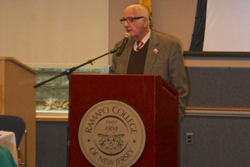
Dr. Paul Winkler, executive director of the New Jersey State Commission on Holocaust Education, setting the stage for the November 15, 2012 Gumpert Teachers’ Workshop on “In Their Own Words: Diaries as a Window into the World of Children in the Holocaust.”
(MAHWAH, NJ) – On November 17, 2012, the Center for Holocaust and Genocide Studies in cooperation with the New Jersey State Commission on Holocaust Education and with funding from the Gumpert Foundation and the New Jersey State Department of Education sponsored a Gumpert Teachers’ Workshop, “In Their Own Words: Diaries as a Window into the World of Children in the Holocaust.” Held at Ramapo College, it was attended by 42 educators from New Jersey and New York.
As noted in Center Director Michael Riff’s welcoming remarks, the workshop was intended to help teachers raise with their students issues relating to the treatment and behavior of children in the Holocaust and other genocides.
Speaking on behalf of the New Jersey Commission on Holocaust Education, Executive Director Dr. Paul Winkler took the matter further by indicating how discussing the experiences of children and teenagers in the Holocaust could help educators to confront issues beyond genocide, including bullying and human rights with their students.

Alexandra Zapruder presenting her keynote presentation on “Diaries as a Window into the World of Children in the Holocaust” at the Gumpert Teachers’ Workshop of November 15, 2012
Author and scholar Alexandra Zapruder delivered an interactive keynote lecture to introduce the topic in which she discussed with workshop participants how to use the diaries from her edited volume Salvaged Pages: Young Writers’ Diaries of the Holocaust. In particular, she stressed how well students relate to the writing of people their own age. They are better able not only to learn and write about the Holocaust, but also to cope more effectively with adolescent behavior issues, stress and traumatic experiences in their own lives.
Published by Oxford University Press in 2005, Salvaged Pages was based on the work she did as a member of the curatorial and education team for Remember The Children: Daniel’s Story, the U.S. Holocaust Memorial Museum’s exhibition for young visitors.Highly acclaimed by reviewers and scholars alike, it won the National Jewish Book Award in the Holocaust category. Salvaged Pages also spawned a documentary film for young audiences, I’m Still Here, which Zapruder wrote and co-produced for MTV. The film was awarded the Jewish Image Award for Best Television Special by the National Foundation for Jewish Culture and was nominated for two Emmy awards.
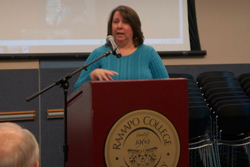
Center board and New Milford High School faculty member, Colleen Tambuscio, relating her students’ experience of commemorating the rescue of a Jewish family during the Holocaust in the Moravian (Czech Republic) village of Trsice (Gumpert Teachers’ Workshop, November 15, 2012)
Also presenting at the workshop was Colleen Tambuscio, who shared her experiences when she took students last year on a study tour of sites in Europe associated with the Holocaust. A Social Studies and Special Education teacher at New Milford High School, she stressed the transformative nature of the trips on student understanding of the Holocaust as well as involvement and engagement. She referred specifically to her students’ visit last year to the Czech Republic town of TÅTsice and their participation in a dedication to a memorial to honor villagers who during WW II courageously hid a Jewish family from deportation by Nazi occupiers.
Culminating the program was a panel discussion among three local residents who survived the Holocaust in hiding. Lola Kaufman, now of New City, New York, recounted how when the Gestapo killed her mother, she was sent by her grandmother to live in the home of a Ukrainian woman and, then, when threatened with exposure, she was forced to hide with another family in a dirt hole beneath a barn. Liberated by the Red Army, she finally found an uncle who survived as a Soviet soldier and with whom she eventually came to America.
At the end, the only thing that she had left from her ordeal was a dress embroidered by her mother and now in the permanent collection of the United States Holocaust Memorial Museum.

Child survivor panelists Lola Kaufman (l.) of New City, New York and Paul Galan (r.) of Suffern, New York.
A different story of survival was told by Suffern, New York resident and retired filmmaker Paul Galan, who trekked with his mother to the relative safety in a partisan redoubt in the mountains of Slovakia, but not before they were imprisoned in a labor camp and experienced several near brushes with German units combing the countryside for Jews and resistors. Miraculously, although separated along the way, after the liberation Paul and his mother were reunited with his father and sister.
No less an ordeal was faced by Eric Mayer of Wayne, New Jersey who in the aftermath of Kristallnacht (November 9/10, 1938) was first sent by his parents to stay with relatives in France, but then was forced to flee south where he eventually, although still in his early teens, joined a partisan group that interdicted a SS division heading to engage allied troops landing in Normandy. Like Mrs. Kaufman and Mr. Galan, the experience of war and hiding from the Germans forced Mayer to grow up quickly. Once the son of a prosperous wine grower and merchant in Worms, Germany at the end of the war he was an orphan, with his father dying in the Sobibor uprising. With the help of relatives, Mr. Mayer and his brother were eventually able to re-settle in Baltimore, Maryland.
As has been the case for some time, evaluations completed by participants revealed that the workshop was a great success. They found all the presentations to be informative and helpful in enabling to develop their skills in teaching of the Holocaust and expressed special gratitude for being able to hear first-hand from survivors about their experiences.
Newsletter Archive
Spring 2011
In This Issue
- Reading and Writing in Teaching About the Holocaust and Genocide Focus of Workshop for Teachers
- Holocaust Commemoration Features Speaker on Demise of Viennese Jewish Community
- Local Rabbi and Historian Takes New Look at German Jewish Service in First World War
- Recent Documentary About Leon Blum, First Jewish Prime Minister of France Shown at Ramapo College
- Author Returns to Speak About Discuss Recent Book on American Heiress Who Resisted Nazis
- Swiss Bank Holocaust Restitution Process Illuminated
- Film on Martin Luther King Screened at Ramapo College
- Noted Historian Examines Connections Between Human Rights and Self-determination and Partitions
Reading and Writing in Teaching About the Holocaust and Genocide Focus of Workshop for Teachers

Prof. Edward Shannon
(MAHWAH, NJ) – A group of more than 80 teachers participated in the Emil Gumpert Teachers’ Workshop held by the Center for Holocaust and Genocide Studies in cooperation with the New Jersey State Commission on Holocaust Education on May 17 at Ramapo College. The workshop was designed to hone participants’ skills in using reading and writing to teach about the Holocaust and genocide.

(Left to Right) Dr. Jennifer Lemberg and Erica Kaufman
Two experienced instructors of writing, Erica Kaufman and Dr. Jennifer Lemberg, modeled an intense array of exercises in which workshop participants engaged in discussing and presenting various types of writing assignments (focused writing, process writing, loop writing). To a large degree, it was a significant reversal of their usual role in the classroom. Judging from the discussion that accompanied each exercise, one would have to conclude that the results were beneficial, and participating teachers would now have new ways to engage their students.
During lunch, participants experienced an enlightening and entertaining PowerPoint presentation on “Comics and Graphic Novels in Teaching about the Holocaust and Genocide” by Dr. Edward Shannon, Professor of Literature at Ramapo College. He showed how the graphic novel developed from the coded imagery and text produced by outsider creators, most of whom were Jewish. Although some even began to address issues related to the Holocaust in the 1950s and 1960s, it was not until Art Spiegelman’s Maus: A Survivor’s Tale in 1986 that the destruction of the Jews in World War II was for the first time depicted through the fate of one victim (Spiegelman’s father Vladek) in comic-strip fashion. As Ed Shannon pointed out, in depicting Jews as mice, while Germans are represented as cats, while other groups are represented variously (Americans as dogs, Poles as pigs and French as frogs and the British as fish), Spiegelman played with his readers’ sense of irony and self-mockery.
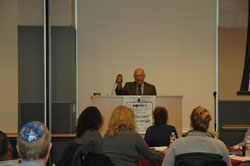
Mr. Erwin Ganz
The final presentation of the day was by a child survivor of Nazi rule in Germany, Mr. Erwin Ganz of Warren, New Jersey. With great eloquence, Mr. Ganz related how in 1933 at the age of three, he and his family were forced to relocate to Bernkastel Koos, Germany. Until April 1939, when the family emigrated and re-settled in Newark, his days were spent mainly traveling to a Jewish school some 35 miles way and suffering the taunts and attacks of non-Jewish children. Judging by the evaluations completed after the event, participants were deeply impressed by Mr. Ganz’s depiction of the life of a young Jewish boy in Nazi Germany.
Holocaust Commemoration Features Speaker on Demise of Viennese Jewish Community
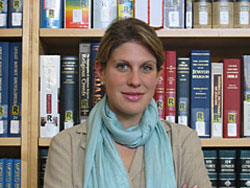
Dr. Ilana Offenberger
(MAHWAH, NJ) On Saturday, April 30, the Center for Holocaust and Genocide Studies of Ramapo College and Temple Beth Haverim Shir Shalom held a Yom HaShoah (Holocaust Remembrance) commemoration in the congregation’s sanctuary that featured a talk by Dr. Ilana Offenberger on “Vienna 1942: The Deportation and Destruction of a Jewish Community.”
Dr. Offenberger’s presentation charted the process of how an end to emigration from the Reich, steadily increasing impoverishment, restriction, humiliation, and a ban on communication with family and loved ones abroad led to the community’s final mortal chapter. With great sensitivity, she paid special attention to the transformation of the Jewish Community (the Israelitische Kultus Gemeinde) from an institution that promoted the emigration and rescue of 136,000 Viennese Jews to an entity that the Nazi authorities forced to organize the deportation to the Third Reich’s ghettos and killing centers of more than 55,000 men, women and children.
In May 2010, Ilana Offenberger completed her Ph.D. in history on “The Nazification of Vienna and the Response of the Viennese Jews” at the Center for Holocaust and Genocide Studies at Clark University. She earned a B.A. in German from Skidmore College. She has been a Crown Family Doctoral Research Fellow, a Strassler Family Center for Holocaust and Genocide Studies Fellow, and a Conference on Jewish Material Claims Against Germany Graduate Studies Fellow. She was a fellow of the United State Holocaust Memorial Museum’s Center for Advanced Holocaust Studies during the 2005-2006 academic year.
The evening also included a commemorative service conducted by Rabbi Joel Mosbacher with program of chorale music performed by the adult choir of Temple Beth Haverim Shir Shalom, under Cantor David Perper.
Local Rabbi and Historian Takes New Look at German Jewish Service in First World War
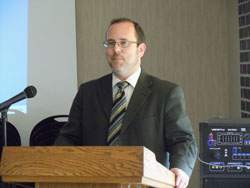
Rabbi Dr. David Fine
(MAHWAH, NJ) On April 18, David J. Fine, a congregational rabbi who is also an historian, spoke at Ramapo College of New Jersey under the auspices of the Center for Holocaust and Genocide Studies and Hillel of Ramapo College.
Entitled “Integration Without Antisemitism: The Experience of Jewish Soldiers in the German Army in World War I,” Fine brought to light new research that casts doubt on the usual narrative of Jewish military service in the Imperial German Army during the First World War. Instead of encountering widespread hostility, evidence from personnel records and letters home indicate an overall situation of acceptance. Jewish soldiers received commissions, and were also promoted and decorated for valor in the field without fuss. In writing home, Jewish servicemen rarely voiced complaints about discrimination. Even the very initiative that prompted the most disquiet among German Jews at the time, the so-called “Jew Census” of 1915, initiated at the insistence of anti-Semites in the Reichstag, painted a picture of widespread service and distinction on the part of Jewish servicemen in the German military.
Fine is rabbi of Temple Israel and Jewish Community Center in Ridgewood, New Jersey. He received his Ph.D. in Modern European history from the City University of New York in 2010. He was ordained as a rabbi by the Jewish Theological Seminary in New York in 1999 and received his B.A. from Wesleyan University in 1994.
Recent Documentary About Leon Blum, First Jewish Prime Minister of France Shown at Ramapo College

(left to Right) Mr. Eric Mayer and Dr. Jean Bodon
(Mahwah, NJ) On April 12, under the auspices of the Center for Holocaust and Genocide Studies and the Communications Arts Major’s Cinematheque Series, Jean Bodon introduced a screening and led a discussion of his film “Léon Blum: For All Mankind.” Originally produced for broadcast on French television, the film examines the life of the former three-time Prime Minister of France. Blum was the architect of the Socialist Party’s Popular Front government that brought a coalition of Communists, liberals and socialists into power from 1936 to 1937. Deported to the infamous Buchenwald concentration camp in 1943 because of his Jewish origins and socialist politics, he narrowly missed execution prior to being liberated by American troops.
After his release and still more respected than loved, Blum headed France’s provisional government from 1946-1947 and negotiated a U.S. loan to France for post-war reconstruction. Best known by his countrymen for introducing labor reforms, including the 40-hour workweek, increased wages and two-week paid vacations for workers, Blum died in 1950.
Bodon, a native of France, teaches film in the Department of Communication Studies of University of Alabama, Birmingham. He teaches courses in television production, cinema and broadcasting. In 2000, he was honored with the President’s Excellence in Teaching Award.
Dr. Bodon has worked as a feature film director and producer and as a director of documentaries and television commercials. His films have been screened at some of the world’s most prominent film presentation organizations including Lincoln Center, the Library of Congress and the Cinémathèque Française. Bodon’s works have been broadcast on HBO, Showtime, Cinemax, The Movie Channel, E!, TLC and other TV outlets around the world. He is also the author of a book on Charlie Chaplin prefaced by Francois Truffaut and numerous essays on film.
Author Returns to Speak About Discuss Recent Book on American Heiress Who Resisted Nazis
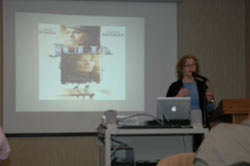
Sheila Isenberg
(MAHWAH, NJ) On April 12, under the auspices of the Center for Holocaust and Genocide Studies and the History Club acclaimed author Sheila Isenberg spoke about her recent book, Muriel’s War: An American Heiress in the Nazi Resistance, published by Palgrave-Macmillan last December.
The book tells the story of a courageous woman who left a life of privilege for a world of danger and international espionage. Born into a wealthy meatpacking dynasty in Chicago and educated at Wellesley, raven-haired beauty Muriel Gardiner renounced her family’s materialistic lifestyle and as a young woman left the United States. First studying at Oxford, then attending the University of Vienna medical school, Muriel befriended Anna Freud and studied the fledgling science of psychoanalysis just as the dark clouds of Hitler’s war were moving across Europe.
During this tumultuous time, she married twice, had a daughter and, in Vienna, fell in love with a leader of the Austrian underground.. When Germany finally annexed Austria in March of 1938, Muriel began to help Jews and anti-fascists escape, smuggling forged documents across borders and risking her own life. Although she eventually returned to New York, Muriel Gardiner continued to use her wealth and vast network of connections to rescue many still trapped in Nazi-dominated Europe.
Here, for the first time, this electrifying woman who impressed everyone she met with her intelligence and powerful personality, receives her due. An American heiress turned resistance hero, Muriel went on to become an eminent psychoanalyst, and was a founder of the International Rescue Committee. Drawing from Gardiner’s unpublished writings and interviews with those who knew her best, Sheila Isenberg offers Muriel’s astonishing story of moral courage and humanistic zeal. With all its twists and turns, this inspiring account reveals a heroic woman who lives on as a legend of her time.
Sheila Isenberg last visited Ramapo College to present a talk, “The Intellectual as Hero: Varian Fry and his Feat of Rescue,” in conjunction with the showing of the United States Holocaust Memorial Museum’s traveling exhibition, Varian Fry, Assignment: Rescue, 1940-1941 at Ramapo College.
Swiss Bank Holocaust Restitution Process Illuminated
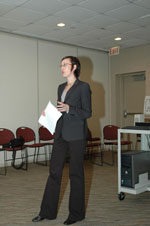
Jaimie Taff, Esq.
(MAHWAH, NJ) On March 22, Jaimie Taff, an attorney who works as the Director in the Office of Special Master Michael Bradfield, Holocaust Victims Litigation, spoke under the auspices of the Center for Holocaust and Genocide Studies about “Holocaust Restitution in the Context of Swiss Deposited Assets Litigation.”
She discussed the landmark case arising from a series of class action lawsuits filed during 1996-1997 in several United States federal courts, alleging that Swiss financial institutions collaborated with and aided the Nazi regime by knowingly retaining and concealing assets of Holocaust victims, and by accepting and laundering illegally obtained Nazi loot and the profits of slave labor
In outlining the litigation historically, she contended that the restitution process has produced a set of outcomes that on the whole has been beneficial to survivors and their heirs. Despite intransigence and heel dragging on the part of some of the institutions involved, political pressure and due diligence combined to enable settlements to be made to many rightful claimants. From the outset, Taff pointed out, one of the problems has been missing documentation on the part of claimants. Good will and patience were just sometimes unable to surmount the lack of adequate paperwork and unfortunate circumstances
Jaimie Taff received her undergraduate degree in History from the University of Maryland (College Park), and a Juris Doctorate from the Catholic University of America in Washington, DC. After working as a legislative analyst with the Congressional Research Service, Ms. Taff began working for the Holocaust Claims Resolution Process Office in 2002, first as an attorney at the Claims Resolution Tribunal in Zurich, Switzerland, and later in her current position as Director in the Office of Special Master Michael Bradfield, which was charged by the relevant court with administering settlement.
Film on Martin Luther King Screened at Ramapo College

Student asking question at screening of “Legacy of a Dream”
On March 21, the Center for Holocaust and Genocide Studies and the Communication Arts Major’s Cinematheque Series hosted a screening of the documentary “Legacy of a Dream,” which summarizes Dr. Martin Luther King’s public life and delineates his central role in the civil rights campaigns.
Richard Kaplan, director and producer of the film, introduced and led a discussion of the film after it was shown. As he explained, the film was produced for the Martin Luther King Foundation and had to be pieced together from bits and pieces of newsreel and television footage, and includes material from the period before the Civil rights leader was a national figure. Narrated by James Earl Jones, the film features Andrew Young and Coretta Scott King.
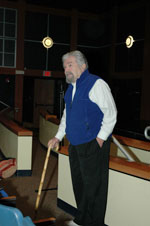
Richard Kaplan
Kaplan has had a distinguished record as a documentary film and television writer, director, and producer, both in the United States and abroad. His work has won considerable acclaim and critical recognition, including two Academy Awards. He is also the recipient of an Emmy Award for “outstanding historical and cultural programming.”
In addition to his many documentaries, made in the course of a career that has spanned almost 60 years, Kaplan’s film work has encompassed the detailed planning and development of theatrical feature films. Last February, the Museum of Modern Art recognized Richard Kaplan’s contribution to documentary filmmaking by running a weeklong series of his work.
Noted Historian Examines Connections Between Human Rights and Self-determination and Partitions
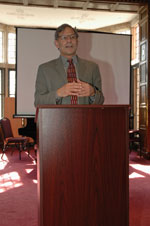
Prof. Eric Weitz
(MAHWAH, NJ) “Toward a Critical History of Human Rights: On the Problems of Self-Determination and Territorial Partitions” was the title of a talk delivered by Dr. Eric D. Weitz, Distinguished McKnight University Professor of History at the University of Minnesota, at a program sponsored by the Center for Holocaust and Genocide and the History Club of Ramapo College on March 8.
Weitz explored how self-determination and partitions demonstrate the entwining of rights with what we would now label crimes against humanity, notably, the practice of forced deportations of targeted populations and the creation of huge refugee streams.
In order to achieve a more nuanced history of human rights in the contemporary world Weitz pursued the following avenues: 1) an intellectual and political history of the concept of self-determination, and 2) an examination of the post-1945, ethnically-based territorial partitions, namely, India/Pakistan, Jordan/Israel, Rwanda/Burundi. Underlying this approach, as Weitz emphasized, is the presumption that human rights is not a singular thing, but a series of phenomena and concepts replete with tensions and contradictions.
Weitz is Distinguished McKnight University Professor of History at the University of Minnesota. Since 2001 he has also been serving as the Arsham and Charlotte Ohanessian Chair in the College of Liberal Arts. Currently, he is on sabbatical at the Davis Center for Historical Studies at Princeton University and writing A World Divided: A New Global History from the French Revolution to the Present. The book, under contract to Princeton University Press, is a combined history of human rights and the segmentation of populations in the modern era. His previous books include A Century of Genocide (2003) and Creating German Communism, 1890-1990 (1996), and most recently, Weimar Germany: Promise and Tragedy (2007), all published by Princeton University Press.
Newsletter - Fall 2007
In This Issue
- November Teachers Workshop On Racial Science in the Holocaust
- Armenian Genocide Linked to Turkish Nationalism and Ottoman Ethnic Cleansing
- Diverse Programming Attracts New Audiences
- Workshop on Darfur Genocide Draws 70 Teachers
- Gerard Prunier, Darfur: the Ambiguous Genocide, Rev. Ed. (Ithaca, N.Y.: Cornell University Press, 2007) ISBN: 0801446023
- Taner Akçam, A Shameful Act: The Armenian Genocide and the Question of Turkish Responsibility (New York: Metropolitan Books, 2006) ISBN: 0805079327
- Friedländer, Saul, The Years of Extermination: Nazi Germany and the Jews, 1939-1945 (New York : HarperCollins Publishers, 2007)
- Steven Bach, Leni: The Life and Work of Leni Riefenstahl (New York: Alfred Knopf, 2007) ISBN: 0375404007
- Götz Aly, Hitler’s Beneficiaries: Plunder, Racial War, and the Nazi Welfare State (New York: Metropolitan Books, 2007) ISBN: 0805079262
November Teachers Workshop On Racial Science in the Holocaust

Dr. Susan Bachrach, keynote speaker, at last November’s Gumpert Teacher Workshop on racial science.
Attended by over 70 teachers from throughout New Jersey, “Barbarous Utopia: from Eugenics to Mass Murder”was the title of a Gumpert Teachers Workshop held at Ramapo College of New Jersey Friday, November 17. It was held in cooperation with the New Jersey State Commission on Holocaust Education and the U.S. Holocaust Memorial Museum, Washington D.C.
Under examination was a scientific movement that had benign beginnings in post-Darwinian genetics but which ended up providing the justification for the industrialized killing in Hitler’s Third Reich. Although the Nazi regime’s attempt to realize its vision of a biologically healthy and ethnically homogeneous population through “racial hygiene” was the workshop’s primary focus, the pervasive influence of the eugenics movement in the United States and Britain was also scrutinized.
Greeting participants was Ramapo College Provost Dr. Beth Barnett. She stressed the important role teachers play in imparting the lessons of the Holocaust to the younger generation and expressed the College’s support for Center for Holocaust and Genocide Studies in that effort.
The featured speaker was Dr. Susan Bachrach, exhibition curator at the U.S. Holocaust Memorial Museum, Washington, D.C. Together with Dieter Kuntz, historian at the museum, she was responsible for Deadly Medicine: Creating the Master Race, the museum’s special exhibition on eugenics and genocidal policies of the Third Reich. Dr. Bachrach’s multi-media presentation traced the development of “Racial Science” from its ostensibly legitimate beginnings in the second half of the nineteenth century to its transformation in the Third Reich into a justification for sterilization and an enterprise for the destruction of human beings deemed unworthy of life.

Dr. Elaine Winshell, professor emerita of Biology at Ramapo College, shedding light on the British and American involvement in eugenics at the Center’s teachers’ workshop, “Barbarous Utopia: from Eugenics to Mass Murder” (November 17, 2006)
Shedding light on the British and American involvement in eugenics was Dr. Elaine Winshell, professor emerita of Biology at Ramapo College and an expert on bridging the disciplinary divide between the natural and social sciences. Although Eugenics is today generally regarded as a pseudo-science and was discredited in the wake of murderous abuses in Germany during the Third Reich, Winschell reminded her audience that the second largest Eugenics movement was in the United States. Starting with Connecticut in 1896, state laws were enacted that prohibited marriage and that forced sterilization of the mentally ill in order to prevent the transmission of mental illness to the next generation. In some ways surprisingly, with the Supreme Court upholding their constitutionality in 1927, it was not until the 1950s that such legislation was finally rescinded.
Mr. Eric Mayer of Wayne, who grew up in the historic southwest German city of Worms, provided a first-hand view of racism in the classrooms of the Third Reich. Before being sent by his family to the relative safety of France, Mr. Mayer spent his first school years in an elementary school that became progressively more inhospitable to Jewish children. It was not only the racially tainted instruction that he and his fellow Jewish students had to face, but also the daily torment and attacks on the part of some of their non-Jewish peers.
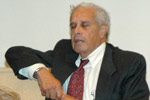
Mr. Eric Mayer of Wayne provided a first-hand view of racism in the classrooms of the Third Reich at the Center’s teachers’ workshop on racial science. (November 17, 2006)
Also taking part in the workshop was Dr. Paul Winkler, executive director of the New Jersey State Commission on Holocaust Education, who provided an overview of the State Mandate on Holocaust Education. In his view, examining the development of “racial science” provides an opportunity for classroom teachers to not only explore the roots of genocide, but also affords an entry point to to build awareness among the young people of New Jersey that the abuse of power in any society often has seemingly innocuous beginnings.
Rounding out the workshop was a presentation on “Teaching about the History of Racism,” by Helen Simpkins, a consultant to the State Commission on Holocaust Education and retired supervisor of Social Studies for the Vernon School District. Her talk provided participants with methodological and practical guidance on how to integrate instruction about racial science into today’s middle and high school classroom.
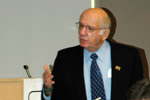
Dr. Paul Winker, Executive director of the New Jersey State Commission on Holocaust Education, providing an overview of the State Mandate on Holocaust Education at the Center’s Gumpert Teachers’ Workshop on racial science, “Barbarous Utopia: from Eugenics to Mass Murder” (November 17, 2006)
An discussion at the conclusion of the day’s proceedings indicated an interest among attendees for a workshop to examine the background and development of the tragic genocide in the Darfur region of Sudan. As a consequence, the Center will be holding a workshop on April 19th, which while focusing on the unfolding tragedy of Darfur, will assist educators on teaching their students about contemporary genocides generally.
Armenian Genocide Linked to Turkish Nationalism and Ottoman Ethnic Cleansing

Some of the 270 attendees at the lecture by Professor Tan Akcam on “The Armenian Genocide and Turkish Nationalism.” (March 29, 2007)
On March 29, before an audience of over 260 students, faculty, and community members, the noted historian Taner Akcam linked the Armenian Genocide of 1915-1917 to
Ottoman Turkey’s population policy implemented on the eve of World War I to maintain Turkish hegemony over a diminished and endangered empire. The event was sponsored by Ramapo College’s Center for Holocaust and Genocide Studies and the Armenian National Committee of New Jersey. Introducing Professor Akcam was Dr. Antranig Kasbarian, Nagorno-Karabagh Program Director of the New York-based Tufenkian Foundation.
One of the first Turkish academics to acknowledge and discuss openly the Armenian Genocide, Akcam based his talk on his book A Shameful Act: The Armenian Genocide and the Question of Turkish Responsibility, published by Metropolitan Books last November (ISBN 0805079327).

Turkish historian Professor Taner Akcam speaking about “Turkish Nationalism and the Armenian Genocide.” (March 29, 2007)
Making extensive use of Ottoman and other sources previously unused by historians of any nationality, Akcam placed the genocide within the context of Turkish nationalism. He showed an empire in a state of collapse plagued by dissension and contradiction. In its dying breath, as Akcam’s presents, Ottoman Turkey lashed out against and attempted to constrain its ethnic and religious minorities.
According to Akcam, the Turkish government adopted a policy of “ethnic cleansing.” Greeks and Albanians were deported from southwestern Turkey, while Moslem Kurds, Central Asians and Arabs were moved from their domiciles in eastern Turkey and subject to “Turkification.” The culmination of this process was the first of the 20th Century’s genocides, in which over a million Armenian men, women and children lost their lives and livelihoods through organized killing, rape and deportation.
Professor Akcam made this tragedy come alive by citing from telegrams and other documents penned by the Ottoman Turkish leadership. They poignantly depicted a situation in which the government pursued its policy of maintaining minority representation in most areas to five to ten percent of the total population against the Armenians with particular vehemence. Among the Turkish claims that Ackam puts to rest was that the government drafted a policy and set aside funds to compensate Armenians for confiscations and loss of income incurred during the expulsions. Documents unearthed by Ackam reveal that the authorities erected a deliberate smokescreen to hide widespread persecution and expropriation.
Taner Akcam was born in the province of Ardahan, Turkey, in 1953. He became interested in Turkish politics at an early age. As the editor-in-chief of a student political journal, he was arrested in 1976 and sentenced to ten years imprisonment. Amnesty International adopted him as one of their first prisoners of conscience, and a year later he escaped by digging a tunnel with a stove leg and fled to Germany, where he received political asylum.
In 1988, Akcam began work as a research scientist at the Hamburg Institute for Social Research. While researching the late Ottoman Empire and early Republic, especially the history of political violence and torture in Turkey, he became interested in the Armenian genocide. In 1996 he received his doctorate from the University of Hanover. His dissertation thesis was titled “The Turkish National Movement and the Armenian Genocide Against the Background of the Military Tribunals in Istanbul Between 1919 and 1922.” Since 2002 he has been a visiting associate professor of history at the University of Minnesota.
Akcam is the author of ten books and numerous articles in Turkish, German, English and other languages.
Diverse Programming Attracts New Audiences

Holocaust Jorge Klainman (Left) of Buenos Aires, Argentina recounting his ordeal while it is rendered into English by the translator of his book, The Seventh Miracle, Kal Wagenheim (October 23, 2006)
Over the last academic year, Ramapo College’s Center for Holocaust & Genocide Studies brought a number of original and informative programs to the attention new audiences. Presenters included Holocaust survivors providing first-hand accounts of their ordeals of living through the Holocaust inferno and academics shedding new light on various aspects of that horrific and perplexing time.
Staring the fall series was a dual-language program in which Jorge Klainman, who lives in Buenos Aires, Argentina, spoke in Spanish on October 23 to an audience of students and community members about his odyssey of survival. Kal Wagenheim, who translated Klainman’s book, The Seventh Miracle, rendered the author’s remarks into English. Among those attending the event was a sizable contingent from Ramapo College’s Spanish Studies, program which co-sponsored the event.
Jorge Klainman began the story of his struggle to remain alive with the depiction of a near-death experience as a slight fifteen-year-old. Marked for death by notorious concentration camp commandant Amon Goeth (unforgettably portrayed by Ralph Fiennes in Steven Spielberg’s Schindler’s List), he miraculously survives his own execution.
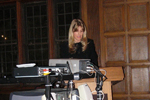
U.S. Holocaust Memorial Museum fellow Ilana Offenberger speaking on the fate of Viennese Jewry after Kristallnacht (the Night of Broken Glass) at the Center’s annual commemoration of the event with Temple Beth Haverim of Mahwah on November 9, 2006.
Klainman is a retired businessman who put his past behind him when he left Europe for Argentina in 1947. After celebrating his 68th birthday in 1996, he decided to break down “the wall of silence” that he had built “brick by brick.” His explanation of the title of his book comes as no surprise. “Six actual miracles occurred, and saved my life,” he says. “The seventh was my being able to write the story, after so much time.”
At a joint commemoration with Temple Beth Haverim of Mahwah on the anniversary of Kristallnacht, United States Holocaust Memorial Museum fellow Ilana Offenberger spoke on “Kristallnacht in Vienna: Fragments of a Shattered World.”Also known as the Night of Broken Glass, the pogrom night of November 9 – 10, 1938, with its widespread and organized nature of attacks, represented a turn in the history of Hitler’s war against the Jews. As Offenburger depicted, Nazification proceeded with such unrelenting rapidity that Jewish families soon found themselves unable to meet the financial requirements to emigrate.
Offenberger’s participation in the Kristallnacht commemoration and classroom visit was made possible through a generous donation from Jack and Goldie Wolf Miller to the United States Holocaust Memorial Foundation’s Center for Advanced Holocaust Studies.
The perplexing question of how was anti-Semitism possible in post-World War Two Poland was the subject of the December 4th talk by Princteton historian Jan Tomasz Gross on his recentlly-published book, Fear: Anti-Semitism in Poland after Auschwitz. Sponsored by Ramapo College’s Center for Holocaust and Genocide Studies, the History Club and Hillel,. The presentation explored how the Polish Catholic Church, Communist Party workers and intellectuals responded to Jews being murdered by their fellow citizens in Kielce and elsewhere, just months after having been liberated from a five-year Nazi occupation.
Jan Gross is known for his work, Neighbors (2001), which argued that Poles, not the German occupiers, as previously believed, conducted a massacre in the Polish town of Jedwabne. The results were the subject of a vigorous debate that is likely to be repeated once Gross’s new book appears in Polish translation.

Rabbi Joel Mosbacher of Temple Beth Haverim of Mahwah (First on Right) speaking with Holocaust survivor Lola Kaufman of New City(Third from Left), who spoke about her experiences as a hidden child in occupied Poland during World War II at the . On her right is her husband Walter Kaufman and her friend and Beth Haverim congregation member Carol Goodman. To her left is Ms. Trude Sokolski of Paramus, a Hololocaust survivor from Austria.
By far the most well attended program of year was a lecture by Turkish born historian Tan Akcam on “Turkish Nationalism and the Armenian Genocide that led off the Spring semester’s programming. Held on March 29th and drawing about 270 community members, it will be discussed in a separate article.
Our Center’s annual Yom HaShoah (Holocaust Remembrance Day) commemoration, held together with Temple Beth Haverim of Mahwah in their sanctuary on April 25, provided the next opportunity for an audience to hear a poignant account of survival. Told in a matter-of-fact tone by Ms. Lola Kaufman of New City, NY, it chronicled her odyssey in hiding following the murder of her parents in the summer of 1942, about a year after the Germans occupied her eastern Polish native city of Czortkow. Only eight at the time, she was eventually forced to join another Jewish family in a cramped hole beneath a barn the house of another woman. Considered an outsider and another mouth to feed, Ms. Kaufman related in an astonishingly self-effacing manner how just before liberation she was evicted from the hole. Advancing Soviet soldiers took her into their care and found her uncle, with whom she emigrated to the United States in 1951.
Throughout her ordeal, Ms Kaufman was only clothed in the summer dress made her mother gave her before she was killed. Five years ago, in January 2002, Ms. Kaufman donated the dress to United States Holocaust Museum. It is now in the museum’s permanent collection and symbolizes the fate of countless Jewish children who experienced a similar fate as Ms Kaufman. Most were less fortunate than she was and did not survive the Holocaust.
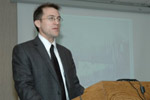
Professor Steven P. Remy of Brooklyn College and the Graduate Center of the City University of New York offers a sobering account of the German academic community from 1933 to 1957 at a Center joint program with Ramapo College’s History Club (April 26, 2007).
Lola Kaufman’s presentation was part of commemorative service in which the Choir of Beth Haverim, under Cantor David Perper, and the Ramapo Chorale and the CantaNova of Ramapo College, under assistant professor of music Lisa Lutter, performed.
Rounding off the year’s programming was a talk on April 26 by another local scholar and author, Professor Steven P. Remy of Brooklyn College and the Graduate Center of the City University of New York. He spoke about his recent book, The Heidelberg Myth: The Nazification and Denazification of a German University (Harvard University Press, 2003) in which he offers a sobering account of the German academic community from 1933 to 1957.
In words and photographs he presented a picture that depicted how, focusing on Heidelberg, the professoriate for the most part willingly embraced Nazi ideology and policy In elaborate postwar self-defense narratives, they portrayed themselves as unpolitical and uncorrupted by the nationalism, authoritarianism and racism of the Nazi years. As a consequence, denazification was resisted and compromised scholars remained in or were restored to their previous positions.
Professor Remy is currently working on a book about German-Jewish refugees in the U.S. Army in World War II. It is our intention to have him back to Ramapo to discuss this new work as soon as possible.
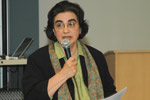
Keynote Dr. Joyce Apsel of New York University at the Center’s Gumpert Teachers’ Workshop, “Teaching About Contemporary Genocides Real-Time: Darfur and Beyond ” (April 19, 2007)

RCNJ student activists, Andy Simon and Steve Pardalis, who founded the campus’ Save Darfur Club recount their club’s activities on campus and in local secondary schools at the Center’s Gumpert Teachers’ Workshop of April 19, 2007

Welcoming participants to the Center’s Gumpert Teachers’ Workshop of April 19 on behalf of the New Jersey State Commission on Holocaust Education was Dr. Dennis Papazian, professor emeritus of History at the University of Michigan
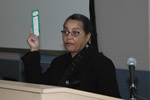
Blanche Foster, executive director of the Newark-based Darfur Rehabilitation Project, explains the work of her organization at the Center’s Gumpert Teachers’ Workshop of April 19, 2007.
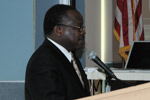
Adelbagy Abushanab, president of the Newark-based Darfur Rehabilitation Project, explains the genesis of the persecution of the people of his native region of Sudan at the Center’s Gumpert Teachers’ Workshop of April 19, 2007.
Workshop on Darfur Genocide Draws 70 Teachers
Held on April 19 and attended by over 70 educators from New Jersey and New York, Teaching About Contemporary Genocides Real-Time: Darfur and Beyond was the title of the latest Gumpert Teachers’ Workshop sponsored by the Center for Holocaust & Genocide Studies in cooperation with the New Jersey State Commission on Holocaust Education.
Setting the tone for the day’s presentation was Ramapo College’s Provost, Dr. Beth Barnett, who acknowledged the work of classroom teachers in fostering civic education and the international responsibility among the young people of our society. Providing a welcome on behalf of the New Jersey State Commission on Holocaust Education was one of its newer members Dr. Dennis Papazian, professor emeritus of History at the University of Michigan. Emphasizing the importance of genocide education in the face of the increasing presence of deniers of various stripes, especially on the Internet, he focused on the attempt not only to deny Turkish responsibility for the Armenian Genocide, but also to harass and criminalize those who assert otherwise.
Delivering the keynote was Dr. Joyce Apsel, a Master Teacher in Humanities at New York University where she teaches Social Foundations and sophomore seminars on genocide, human rights and peace studies. Dr. Apsel holds a M.A. degree and a Ph.D. from the University of Rochester as well as a J.D. from the Rutgers School of Law in Newark. A resident of Ridgewood, New Jersey, Dr. Apsel is the founder and director of Rights Works International, a not-for-profit human rights education project. She lectures and writes on issues of genocide, peace and human rights and is co-editor of Teaching about Genocide (3rd ed. 2003), and editor of Teaching About Human Rights (2005). Most recently, she compiled and helped write the highly acclaimed teaching guide Darfur: Genocide Before Our Eyes (2005), on which her hands-on talk was largely based.
Next on the agenda was Adelbagy Abushanab, president of the Newark-based Darfur Rehabilitation Project and, like Dennis Papazian, also a member of the New Jersey State Commission on Holocaust Education. A native of the troubled Sudanese region, he depicted how the military dictatorial elite in the Sudanese capital essentially engineered the tragedy in Darfur to extend and reifroce its control over the country’s vast western region. In recounting his experiences growing up in a village and studying accounting in Khartoum, Mr. Abushanab stressed how until the 1990s the local “African” (settled farming) and “Arab” (nomadic herder) peoples lived along side each other in relative harmony. At that time, however, the increasingly Islamist central government began exploiting competition over resources, replacing traditional conflict resolution mechanisms with conflict itself, which it organized and financed.
Following lunch, there were two more presentations. The first was by Hunterdon Regional High School (Clinton, New Jersey) teacher Ann Helfant, who in her previous position at Ridge High School (Basking Ridge, New Jersey) developed a course covering genocide throughout history, ranging from the Hereros in Africa to Darfur and was also the advisor for the Ridge branch of Help Darfur Now. In addition to finding her enthusiasm infectious, many of the teachers attending the workshop commented on how grateful they were for Helfant’s suggestions about lesson plans and teaching strategies.
Concluding the day’s events was a presentation by two Ramapo College student activists, Andy Simon and Steve Pardalis, who founded the campus’s Save Darfur Club. In recounting their club’s activities on campus and in local secondary schools, they modeled and depicted how students were not only able to raise awareness about the unfolding tragedy of Darfur, but also engage in activism and play a significant part in genocide education. It should not come as a surprise, therefore, that the Save Darfur Club received the “Outstanding New Organization of the Year Award” of 2006/2007 from Ramapo College’s Division Student Affairs.
Gerard Prunier, Darfur: the Ambiguous Genocide, Rev. Ed. (Ithaca, N.Y.: Cornell University Press, 2007) ISBN: 080144602
Despite pronouncements from world leaders, resolutions from international bodies and negotiations among the parties involved, genocide continues in the Darfur region of Sudan. The marvels of technology have enabled Google and the United Staes Holocaust Museum to display satellite photographs of the crisis zone with explicating material that make it possible to know what is going on there in real-time. And the humanitarian disaster continues with at least 200,00 people killed and 2.5 million Darfur “Africans” driven from their homes by the infamous state-supported “Janjaweed” militia.
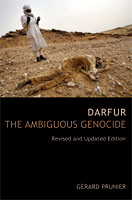 This situation is complex and a long time in the making. Untangling it is not easy. But this is exactly what Gerard Prunier does in the recently revised edition of his book, Darfur: the Ambiguous Genocide. As he explains, at the heart of the crisis is the determination of the present-day Khartoum-based Arab elite to assert its hegemony over the mostly African Muslim farmers of the embattled western region that in pre-colonial times constituted an independent and significant sultanate. The tragedy of Darfur, as Prunier makes clear, was at least twenty years in the making with Arab nationalism, drought, foreign interference and civil conflict across the border in Chad all playing their part in its unfolding.
This situation is complex and a long time in the making. Untangling it is not easy. But this is exactly what Gerard Prunier does in the recently revised edition of his book, Darfur: the Ambiguous Genocide. As he explains, at the heart of the crisis is the determination of the present-day Khartoum-based Arab elite to assert its hegemony over the mostly African Muslim farmers of the embattled western region that in pre-colonial times constituted an independent and significant sultanate. The tragedy of Darfur, as Prunier makes clear, was at least twenty years in the making with Arab nationalism, drought, foreign interference and civil conflict across the border in Chad all playing their part in its unfolding.
One matter, perhaps, requires a bit of criticism. Prunier sometimes sounds dismissive in noting the influence of the increasingly vocal advocacy groups and the celebrities who have played a key role in making their voices heard in the arena of world opinion. Without rallies and letter-writing campaigns and the likes of George Clooney, Don Cheadle and Mia Farrow, whose pronouncements have been heard from Washington to Beijing, it is unlikely that there would be any hope at all of resolving the conflict.
Taner Akçam, A Shameful Act: The Armenian Genocide and the Question of Turkish Responsibility (New York: Metropolitan Books, 2006) ISBN: 0805079327
One of the first Turkish scholars to systematically study slaughter of one million Armenians by the Ottoman Turks during World War I, Taner Akçam lays to rest claims by apologists and deniers who minimize the deaths and claim that they were incidental to the war effort, or the fault of the Armenians themselves because they were disloyal.
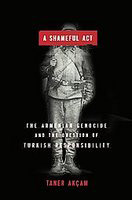 Basing his account on newly available archival sources, Akçam makes it clear that the persecution of the Armenians was part of an overall Ottoman population policy that aimed at Turkification and the limitation of its non-Turkish population. The policy began in the years before the First World War with the “ethnic cleansing” Greeks and Albanians from southwestern Turkey and spread to encompass Moslem Kurds, Central Asians and Arabs in the eastern part of the country. As Akçam points out, it was an outgrowth of the empire’s decline and was fueled by the nationalism of a younger generation of intellectuals and military leaders schooled in Central Europe.
Basing his account on newly available archival sources, Akçam makes it clear that the persecution of the Armenians was part of an overall Ottoman population policy that aimed at Turkification and the limitation of its non-Turkish population. The policy began in the years before the First World War with the “ethnic cleansing” Greeks and Albanians from southwestern Turkey and spread to encompass Moslem Kurds, Central Asians and Arabs in the eastern part of the country. As Akçam points out, it was an outgrowth of the empire’s decline and was fueled by the nationalism of a younger generation of intellectuals and military leaders schooled in Central Europe.
Akçam end his study with an examination of the role of Mustafa Kemal Ataturk, the founder of modern Turkey, in failing not only to take responsibility for the genocide, but also for continuing the pre-war policy of removing or limiting the non-Turkish peoples living on the new republic’s territory. Ironically, the title for Akcam’s book, “A Shameful Act,” comes from a speech by Ataturk himself. Unfortunately, however, instead of coming to terms with the crimes that the wartime regime perpetrated, Ataturk set a course of denial from which the government of Turkey has not veered to this day.
Friedländer, Saul, The Years of Extermination: Nazi Germany and the Jews, 1939-1945 (New York : HarperCollins Publishers, 2007)
Ten years in the making and anxiously awaited, Saul Friedlander’s second volume of the Holocaust, The Years of Extermination, displays the author’s unique talents as a meticulous scholar, insightful analyst and artful chronicler of the past.
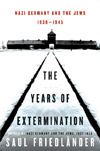 Born and raised in Prague, Friedlander survived Hitler’s war against the Jews hidden in a French Catholic boarding school. Emigrating to Israel in ?, he today holds joint appointments at Tel Aviv University and UCLA. Without the slightest hint of pathos or sentimentality, relying heavily on their testimonies [of one kind or another], he consistently weaves into his chronicle the perspective of the Shoah’s Jewish victims.
Born and raised in Prague, Friedlander survived Hitler’s war against the Jews hidden in a French Catholic boarding school. Emigrating to Israel in ?, he today holds joint appointments at Tel Aviv University and UCLA. Without the slightest hint of pathos or sentimentality, relying heavily on their testimonies [of one kind or another], he consistently weaves into his chronicle the perspective of the Shoah’s Jewish victims.
Taking into account and countering much recent scholarship, Friedlander re-focuses attention on the role of anti-Semitism in explaining the murderous campaign of the Nazis and their collaborators. While accepting that economic motives played a part in Hitlers campaign against the Jews, he believes that there are enough contradictions to warrant further assessment:
“But why should the Jews have been exterminated in the face of the demands of the Wehrmacht for skilled labor and economic arguments, unless entirely different reasons motivated the master of the Reich and the multitude of his acolytes and supporters? Unavoidably, the questions leads us back once again to the phantasmal role played by “the Jew” in Hitler’s Germany and the surrounding world.”
Steven Bach, Leni: The Life and Work of Leni Riefenstahl (New York: Alfred Knopf, 2007) ISBN: 0375404007
While assessing Leni Riefenstahl’s legendary career as a filmmaker and favorite of Hitler, Bennington College and Columbia film school professor Steven Bach opens a window into the idiosyncratic world of Nazi Germany in which the strange, evil, familiar and banal combined to produce such harrowing consequences. More than talent, skill and determination Leni Riefenstahl’s success, as a filmmaker, Bach makes abundantly clear, was determined by the patronage she cultivated and enjoyed at the top.
He also makes it clear that her longest-lasting influence will be as the author of the book on propagandist imagery, even if unknowingly, her haunting and masterful films glorifying Hitler and the Third Reich, Triumph of the Will and Olympia, are the paradigms for putting the modern political campaign on screen.
Bach’s meticulous and engaging book confirms her presence at the notorious 1939 massacre of Jews in Konsakie during the Nazi invasion of Poland and her use of interned Roma (gypsy) extras later deported to Auschwitz in her film Tiefland. Riefenstahl’s claims of ignorance and political naiveté should be put to rest forever.
Götz Aly, Hitler’s Beneficiaries: Plunder, Racial War, and the Nazi Welfare State (New York: Metropolitan Books, 2007) ISBN: 0805079262
Today, as we grapple with issues like universal health care and the high cost of Social Security, it is little known that Nazi Germany during the Second World War not only expanded, but also introduced numerous social programs that would serve as models for much of the rest of world for years to come.
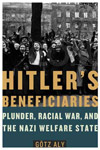 Ever attuned to public sentiment, Hitler and his henchmen established a “redistributive state” on an unparalleled scale. They introduced a marriage tax credit in 1934 and health insurance for retirees in 1941. The number of public holidays was doubled in1934, and in 1940, the Nazi government the taxes on overtime were rescinded. In some ways ever more astonishing, the wives of German servicemen during the war received subsistence benefits twice that of their British and American counterparts. What is more, fearing public opposition, even though the needs of the treasury and the need of labor might have dictated otherwise, this situation was never tampered with.
Ever attuned to public sentiment, Hitler and his henchmen established a “redistributive state” on an unparalleled scale. They introduced a marriage tax credit in 1934 and health insurance for retirees in 1941. The number of public holidays was doubled in1934, and in 1940, the Nazi government the taxes on overtime were rescinded. In some ways ever more astonishing, the wives of German servicemen during the war received subsistence benefits twice that of their British and American counterparts. What is more, fearing public opposition, even though the needs of the treasury and the need of labor might have dictated otherwise, this situation was never tampered with.
Put bluntly, as the Berlin-based Aly clearly shows, to pay for their welfare state the Nazis robbed the Jews and the occupied countries. And if we are to accept his analysis, the material benefits gained through the direct seizure of Jewish property, including furniture and other household effects, made the German people less likely to oppose the Nazi regime and more than willing to turn a blind eye to physical persecution.
Aside from the fiscal incongruity that expropriations never accounted for more than 5% of the Third Reich’s budget, pointed out by a number of reviewers, the element most missing from Aly’s account is the role of anti-Semitism. Simply put, before greed and self-interest came into play for their plunder to take place, the Jews of occupied Europe had to become the “other.” It was a dynamic borne of indifference, denial and outright hatred.
Copyright ©2025 Ramapo College Of New Jersey. Statements And Policies. Contact Webmaster.


Follow Us!